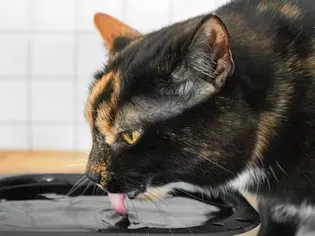Struvite Crystals in Cats
Updated on 04/26/24

Unlock the Secrets: Exploring the Mysterious World of Struvite Crystals in Cats
If you're a cat parent, the words "struvite crystals" may have sent shivers down your spine. These tiny but mighty crystals can wreak havoc on your feline friend's urinary tract, leading to a whole host of uncomfortable and potentially even dangerous health issues.
But fear not! In this comprehensive guide, we'll dive into the intriguing world of struvite crystals in cats, empowering you with all the knowledge you need to prevent, diagnose, and effectively manage these tiny yet impactful urinary irritants.
Chapter 1: Unveiling the Nature of Struvite Crystals
Struvite crystals, also known as magnesium ammonium phosphate crystals, are crystalline deposits that form in the urinary tract of cats. These crystals are composed of magnesium, ammonium, and phosphate ions and can vary in size and shape.
Causes of Struvite Crystal Formation:
* High Urinary pH: Struvite crystals thrive in an alkaline urinary environment (pH greater than 7).
* High Concentration of Ions: A high concentration of magnesium, ammonium, and phosphate ions in the urine can promote crystal formation.
* Urinary Tract Infection (UTI): UTIs can alter the pH of the urine and increase ion concentration, creating a conducive environment for struvite crystal growth.
* Diet: Diets high in magnesium, phosphorus, or fiber can contribute to struvite crystal formation.
Chapter 2: Recognizing the Signs and Symptoms
Early detection of struvite crystals is crucial for timely intervention and effective management. Here are some common signs and symptoms to watch out for:
* Urinary Tract Issues: Difficulty urinating, straining to urinate, frequent urination, or bloody urine.
* Urinary Blockage: In severe cases, struvite crystals can obstruct the urinary tract, leading to a life-threatening emergency.
* Increased Water Intake: Cats with struvite crystals may drink more water to dilute the urine and alleviate discomfort.
* Changes in Litter Box Habits: Struvite crystals can irritate the bladder, causing cats to avoid the litter box or use it less frequently.
* Loss of Appetite: Discomfort and pain associated with struvite crystals can affect appetite.
Chapter 3: Diagnosis and Treatment Options
If you suspect your cat may have struvite crystals, prompt veterinary care is essential. Your veterinarian will perform a urinalysis to confirm the presence of crystals and determine their type.
Treatment Approaches:
* Dietary Modification: A veterinarian-recommended diet specifically formulated to dissolve struvite crystals will be prescribed. These diets typically have a low pH, low magnesium, low phosphorus, and high protein content.
* Fluid Therapy: Intravenous fluids may be administered to hydrate the cat and promote urine production.
* Medications: In some cases, medications such as antibiotics or anti-inflammatories may be prescribed to address underlying infections or reduce discomfort.
* Surgery: In severe cases of urinary blockage, surgery may be necessary to remove the crystals and restore urine flow.
Chapter 4: Prevention is Key
Proactively preventing struvite crystal formation is the best defense for your cat's urinary health. Here are some preventative measures:
* Maintain a Healthy Diet: Feed your cat a balanced diet that is appropriate for their age, lifestyle, and urinary health. Consult your veterinarian for personalized dietary recommendations.
* Encourage Water Intake: Ensure your cat has access to fresh water at all times to promote hydration and dilute urine.
* Monitor Urinary pH: Regular urinalysis can help detect changes in urinary pH and early signs of crystal formation.
* Regular Veterinary Check-ups: Routine veterinary check-ups allow your veterinarian to assess your cat's urinary health and proactively manage any underlying issues.
Conclusion
Understanding struvite crystals in cats is essential for maintaining their urinary well-being. By recognizing the signs and symptoms, seeking prompt veterinary care, and implementing appropriate treatment and preventative measures, you can empower your furry friend to live a healthy and crystal-free life. Remember, early detection and proactive management are the keys to safeguarding your cat's urinary health.
Explore More Pets

Cat Behavior Problems
How to Stop Aggression in Kittens

Long-Haired Cat Breeds
Siberian Cat: Breed Profile, Characteristics, & Care

Cat Behavior Problems
How to Stop Kittens From Scratching and Biting

Long-Haired Cat Breeds
Turkish Angora: Cat Breed Profile, Characteristics & Care

Basic Training
How to Socialize Your Kitten

Short-Haired Cat Breeds
Cute Pictures & Facts About Calico Cats & Kittens

Litter Box Training
Training Your Kitten to Use the Litter Box

Long-Haired Cat Breeds
10 Fun Facts About White Cats